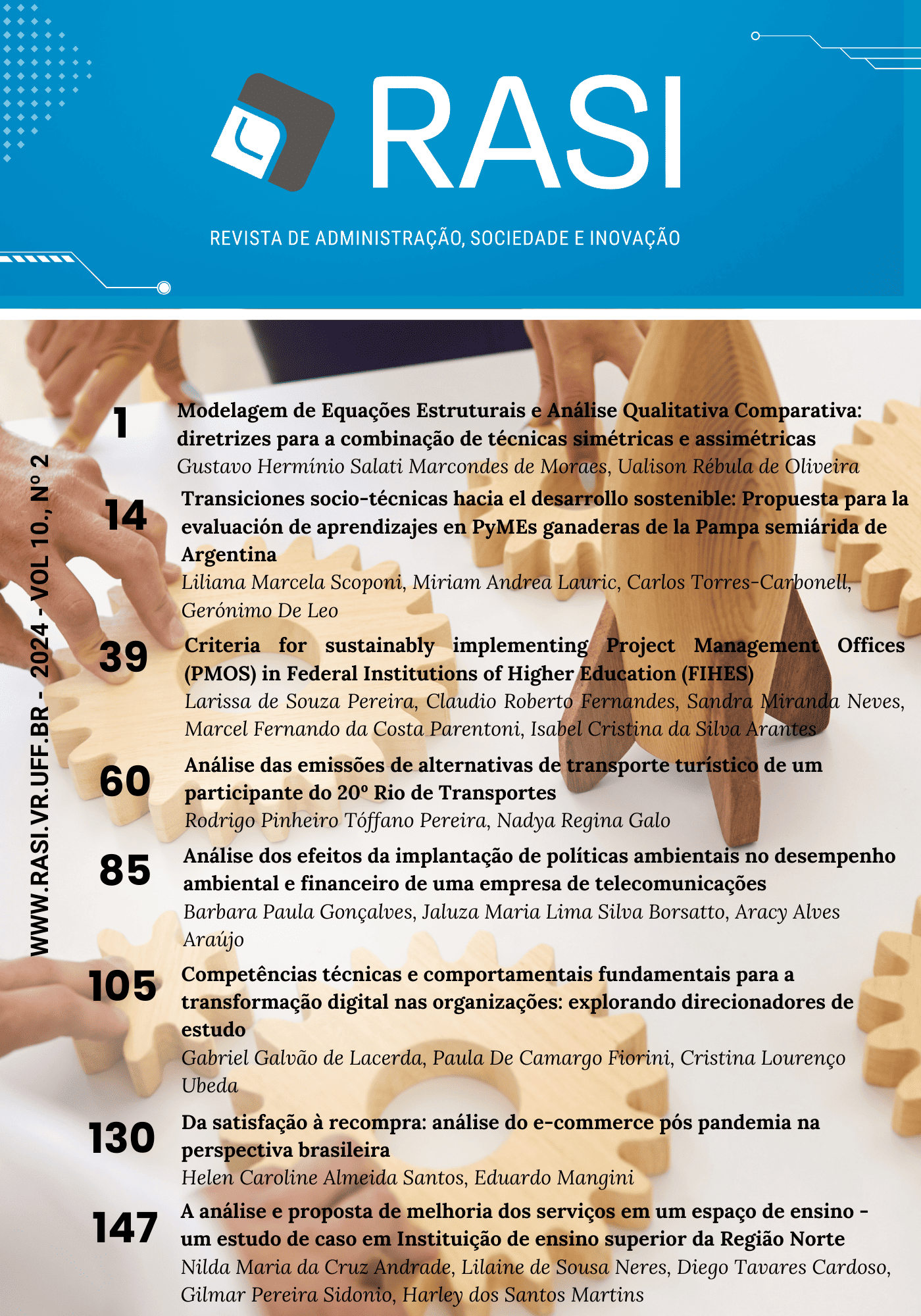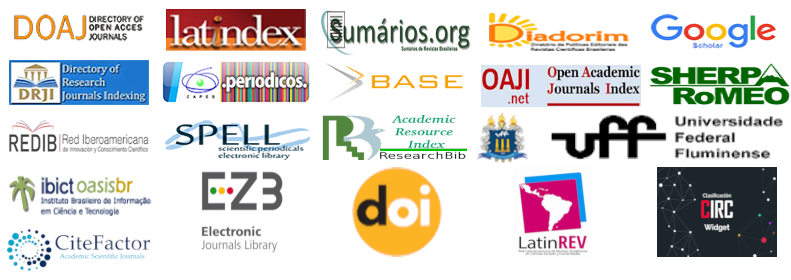Modelagem de Equações Estruturais e Análise Qualitativa Comparativa: diretrizes para a combinação de técnicas simétricas e assimétricas
DOI:
https://doi.org/10.20401/rasi.10.2.931Palavras-chave:
Modelagem de Equações Estruturais, Análise Qualitativa ComparativaResumo
Editorial
Downloads
Referências
Andrés-Sánchez, J., & Puchades, L. G. V. (2023). Combining fsQCA and PLS-SEM to assess policyholders’ attitude towards life settlements. European Research on Management and Business Economics, 29(2), 100220. https://doi.org/10.1016/j.iedeen.2023.100220
Cepeda-Carrion, G., Cegarra-Navarro, J. G., & Cillo, V. (2019). Tips to use partial least squares structural equation modelling (PLS-SEM) in knowledge management. Journal of Knowledge Management, 23(1), 67–89. https://doi.org/10.1108/JKM-05-2018-0322
Cifci, I., Kahraman, O. C., Tiwari, S., & Rasoolimanesh, S. M. (2023). Demystifying meal-sharing experiences through a combination of PLS-SEM and fsQCA. Journal of Hospitality Marketing & Management, 32(7), 843–869. https://doi.org/10.1080/19368623.2023.2215222
Cole, D. A., & Preacher, K. J. (2014). Manifest variable path analysis: Potentially serious and misleading consequences due to uncorrected measurement error. Psychological Methods, 19(2), 300–315. https://doi.org/10.1037/a0033805
Das, S., & Datta, B. (2024). Application of UTAUT2 on Adopting Artificial Intelligence Powered Lead Management System (AI-LMS) in passenger car sales. Technological Forecasting and Social Change, 201, 123241. https://doi.org/10.1016/j.techfore.2024.123241
Do Prado, N. B., Moraes, G., Fischer, B. B., Anholon, R., & Rampasso, I. S. (2022). Antecedents of environmental value creation: an analysis with ecopreneurs in a developing country. International journal of sustainable development and world ecology, 29(8), 709–724. https://doi.org/10.1080/13504509.2022.2080296
Durdyev, S., Ismail, S., Ihtiyar, A., Abu Bakar, N. F. S., & Darko, A. (2018). A partial least squares structural equation modeling (PLS-SEM) of barriers to sustainable construction in Malaysia. Journal of Cleaner Production, 204, 564–572. https://doi.org/10.1016/j.jclepro.2018.08.304
Fauzi, M. A. (2022). Partial least square structural equation modelling (PLS-SEM) in knowledge management studies: Knowledge sharing in virtual communities. Knowledge Management & E-Learning: An International Journal, 103–124. https://doi.org/10.34105/j.kmel.2022.14.007
Fiss, P. C. (2011). Building better causal theories: a fuzzy set approach to typologies in organization research. Academy of Management Journal, 54(2), 393–420.
Guenther, P., Guenther, M., Ringle, C. M., Zaefarian, G., & Cartwright, S. (2023). Improving PLS-SEM use for business marketing research. Industrial Marketing Management, 111, 127–142. https://doi.org/10.1016/j.indmarman.2023.03.010
Hair, J. F., Hult, G. T. M., Ringle, C. M., Sarstedt, M., & Thiele, K. O. (2017). Mirror, mirror on the wall: a comparative evaluation of composite-based structural equation modeling methods. Journal of the Academy of Marketing Science, 45(5), 616–632. https://doi.org/10.1007/s11747-017-0517-x
Hair, J. F., Sarstedt, M., Ringle, C. M., & Gudergan, S. P. (2024). Advanced Issues in Partial Least Squares Structural Equation Modeling (PLS-SEM) (2e) (Thousand Oaks). Sage.
Huang, Y., Li, P., Bu, Y., & Zhao, G. (2023). What entrepreneurial ecosystem elements promote sustainable entrepreneurship? Journal of Cleaner Production, 422, 138459. https://doi.org/10.1016/j.jclepro.2023.138459
Kaya, B., Abubakar, A. M., Behravesh, E., Yildiz, H., & Mert, I. S. (2020). Antecedents of innovative performance: Findings from PLS-SEM and fuzzy sets (fsQCA). Journal of Business Research, 114, 278–289. https://doi.org/10.1016/j.jbusres.2020.04.016
Lee, J. H., Joo, D., Lee, C.-K., Parkt, Y. N., & Kwon, Y.-J. (2022). The role of residents’ sustainable intelligence in agricultural heritage site management: Insights from PLS-SEM and Fs/QCA. Journal of Hospitality and Tourism Management, 52, 65–74. https://doi.org/10.1016/j.jhtm.2022.06.004
Magno, F., Cassia, F., & Ringle, C. M. (2022). A brief review of partial least squares structural equation modeling (PLS-SEM) use in quality management studies. The TQM Journal. https://doi.org/10.1108/TQM-06-2022-0197
Moraes, G. H. S. M., Fischer, B., Salles-Filho, S., Meissner, D., & Dabic, M. (2023). More than one way to get there: a configurational view on performance drivers in knowledge-intensive entrepreneurship. Journal of Knowledge Management, 27(11), 205–230. https://doi.org/10.1108/JKM-03-2023-0267
Moraes, G. H. S. M., Pelegrini, G. C., Marchi, L. P., Pinheiro, G. T., & Cappellozza, A. (2022). Antecedents of big data analytics adoption: an analysis with future managers in a developing country. The Bottom Line, 35(2/3), 73–89. https://doi.org/10.1108/BL-06-2021-0068
Olya, H. G. T. (2023). Towards advancing theory and methods on tourism development from residents’ perspectives: Developing a framework on the pathway to impact. Journal of Sustainable Tourism, 31(2), 329–349. https://doi.org/10.1080/09669582.2020.1843046
Pappas, I. O., & Woodside, A. G. (2021). Fuzzy-set Qualitative Comparative Analysis (fsQCA): Guidelines for research practice in Information Systems and marketing. International Journal of Information Management, 58, 102310. https://doi.org/10.1016/j.ijinfomgt.2021.102310
Pelegrini, G. C., & Moraes, G. H. S. M. (2021). Does gender matter? A university ecosystem, self-efficacy and entrepreneurial intention analysis in Brazilian universities. Gender in Management. https://doi.org/10.1108/GM-01-2021-0007
Ragin, C. C. (2008). Redesigning Social Inquiry: Set Relations in Social Research. University of Chicago Press.
Rasoolimanesh, S. M., Ringle, C. M., Sarstedt, M., & Olya, H. (2021). The combined use of symmetric and asymmetric approaches: partial least squares-structural equation modeling and fuzzy-set qualitative comparative analysis. International Journal of Contemporary Hospitality Management, 33(5), 1571–1592. https://doi.org/10.1108/IJCHM-10-2020-1164
Richter, N. F., Schubring, S., Hauff, S., Ringle, C. M., & Sarstedt, M. (2020). When predictors of outcomes are necessary: guidelines for the combined use of PLS-SEM and NCA. Industrial Management & Data Systems, 120(12), 2243–2267. https://doi.org/10.1108/IMDS-11-2019-0638
Rihoux, B., & Ragin, C. (2009). Configurational Comparative Methods: Qualitative Comparative Analysis (QCA) and Related Techniques. SAGE Publications, Inc. https://doi.org/10.4135/9781452226569
Santana, R. S., Moraes, G. H. S. M. de, & Silva, H. M. R. da. (2021). Relational attractiveness between supplier-customer in a supply chain. RAUSP Management Journal, 56(1), 109–128. https://doi.org/10.1108/RAUSP-09-2019-0202
Sukhov, A., Friman, M., & Olsson, L. E. (2023). Unlocking potential: An integrated approach using PLS-SEM, NCA, and fsQCA for informed decision making. Journal of Retailing and Consumer Services, 74, 103424. https://doi.org/10.1016/j.jretconser.2023.103424
Väätäinen, M., & Dickenson, P. (2019). (Re)examining the effects of athlete brand image (ABI) on psychological commitment: an empirical investigation using structural equation modelling (SEM) and fuzzy set qualitative comparative analysis (fsQCA). European Sport Management Quarterly, 19(2), 244–264. https://doi.org/10.1080/16184742.2018.1508242
Woodside, A. G. (2013). Moving beyond multiple regression analysis to algorithms: Calling for adoption of a paradigm shift from symmetric to asymmetric thinking in data analysis and crafting theory. Journal of Business Research, 66(4), 463–472. https://doi.org/10.1016/j.jbusres.2012.12.021
Yesuf, Y. M., Getahun, D. A., & Debas, A. T. (2024). Determinants of employees’ creativity: modeling the mediating role of organizational motivation to innovate. Journal of Innovation and Entrepreneurship, 13(1), 8. https://doi.org/10.1186/s13731-024-00364-w
Yuan, K. H., Wen, Y., & Tang, J. (2020). Regression Analysis with Latent Variables by Partial Least Squares and Four Other Composite Scores: Consistency, Bias and Correction. Structural Equation Modeling: A Multidisciplinary Journal, 27(3), 333–350. https://doi.org/10.1080/10705511.2019.1647107
Zhang, H., & Zhang, Y. (2019). Comparing fsQCA with PLS-SEM: predicting intended car use by national park tourists. Tourism Geographies, 21(4), 706–730. https://doi.org/10.1080/14616688.2018.1540652
Zhao, J., & Yan, C. (2020). User Acceptance of Information Feed Advertising: A Hybrid Method Based on SEM and QCA. Future Internet, 12(12), 209. https://doi.org/10.3390/fi12120209
Downloads
Publicado
Edição
Seção
Licença
Copyright (c) 2024 Revista de Administração, Sociedade e Inovação

Este trabalho está licenciado sob uma licença Creative Commons Attribution 4.0 International License.
A RASI, de acordo com a Lei nº 9.610, de 19.02.98 que altera, atualiza e consolida a legislação sobre direitos autorais e dá outras providências, adota as seguintes condições da Cessão de Direitos Autorais:
- A Revista de Administração Sociedade e Inovação (RASI) mantém, com a cessão dos direitos autorais, a posse dos direitos sobre os conteúdos por ela publicados;
- O autor retém seus direitos morais do conteúdo, incluindo o direito de ser identificado como autor sempre que o conteúdo for publicado;
- Apesar da atribuição dos direitos autorais o autor retém o direito de reutilizar o material em coleções futuras de seu próprio trabalho sem ônus. Os reconhecimentos da publicação anterior na RASI são as únicas exigências em tais casos;
- O autor pode fazer fotocópias do conteúdo, ou distribuí-lo por meio de correio eletrônico ou fax, desde que destinadas às suas próprias aulas e com finalidade de atender objetivos de pesquisa, sob a condição de que: (a) tais cópias não sejam revendidas e (b) referência a fonte original da publicação e o nome da RASI estejam indicados claramente em todas as cópias feitas do material.











